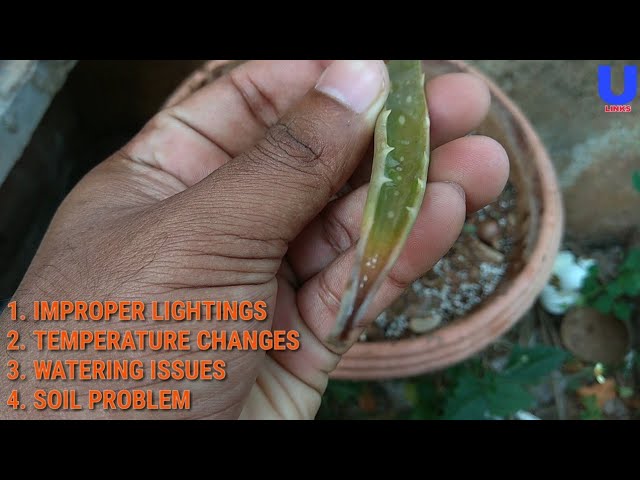Aloe vera plant leaves turning brown
Aloe Vera plant leaves turning brown. fix the problem of aloe Vera leaves turning brown. Fix dying aloe Vera plant. see more here: https://goo.gl/BVIU4G
Improper Lighting
Aloe vera plants do well grown in direct sunlight, but sometimes too much light can damage your aloe’s leaves. Plants grown in very hot sunlight can become sunburned, leading to browning. This is especially common with plants that have been moved from a shadier location to a very sunny one suddenly, with no adjustment period. If you plan on moving your indoor aloe outdoors, you’ll need to start with a shady spot and gradually transition the plant to a sunnier spot. To deal with sunburned aloe plants, simply move them into a spot with more shade and diffuse light.
Temperature Changes
Aloe vera plants are sensitive to sudden changes in temperature. When the weather becomes cold and wet, move your potted aloe vera inside; otherwise it could start to brown and die. Ideally, the temperature for these plants shouldn’t dip below 50 degrees Fahrenheit. Also, if moving a potted aloe plant outdoors for the summer, be aware that very hot and dry conditions can stress your aloe, leading to brown leaves. You’ll want to keep the plant in a cooler location to start and gradually transition it into a warmer one. For non-potted plants that can’t be moved, insulate them with blankets during very cold months, especially at night.
Watering Issues
Known for their ability to store water within their leaves, aloe plants do not need frequent watering. In fact, over watering your aloe can lead to root rot and browning. This is especially true for potted aloe plants that don’t have proper drainage holes. To prevent browned leaves due to over watering, water your aloe only when the soil has completely dried out. When you do water the plant, do so thoroughly so you soak the soil. In winter temperatures below 60 degrees Fahrenheit outdoors, water your aloe much less frequently because the plant is in a dormant phase. Less frequent watering also helps to minimize frost damage from wet soil if temperatures drop below freezing. If your aloe is looking withered, dry and brown, water it a bit more frequently, as it may not be getting enough water, especially if the weather is very warm.
Soil Problems
As succulents, aloe vera plants require well-drained soil to prevent root rot, which leads to a brown plant. Ideally, you want a cacti potting mix or garden soil that contains extra perlite and sand. The same soil recommendation applies both to potted plants and non-potted ones.
In terms of fertilization, you’ll need to fertilize your aloe plant once per month, only in the spring and summer months. A houseplant fertilizer diluted to half the usual strength works well.
————————————————-
Follow us on –
Facebook page : https://goo.gl/WiA0BF
Twitter profile : https://goo.gl/xTJJ75
Google+: https://goo.gl/mUf5q6
ulinks is my channel about gardening. Gardening is my passion, and growing Food Forests is my specialty. I go beyond organic gardening and work with nature rather then against it. Gardening doesn’t have to be hard, and you don’t have to be a servant to the garden.



![[ID: JqQ9hRGoc3w] Youtube Automatic](https://okumasaati.net/wp-content/uploads/2020/10/id-jqq9hrgoc3w-youtube-automatic-360x203.jpg)
![[ID: _eS7hD_-Hrc] Youtube Automatic](https://okumasaati.net/wp-content/uploads/2020/10/id-es7hd-hrc-youtube-automatic-360x203.jpg)
![[ID: vP50g1KGoTo] Youtube Automatic](https://okumasaati.net/wp-content/uploads/2020/10/id-vp50g1kgoto-youtube-automatic-360x203.jpg)
![Private: [ID: VwII4y5vpyU] Youtube Automatic](https://okumasaati.net/wp-content/uploads/2020/10/private-id-vwii4y5vpyu-youtube-a-360x203.jpg)
![[ID: uAexhZVJUnI] Youtube Automatic](https://okumasaati.net/wp-content/uploads/2020/10/id-uaexhzvjuni-youtube-automatic-360x203.jpg)
![Private: [ID: dClsXcFY2T8] Youtube Automatic](https://okumasaati.net/wp-content/uploads/2020/10/private-id-dclsxcfy2t8-youtube-a-360x203.jpg)